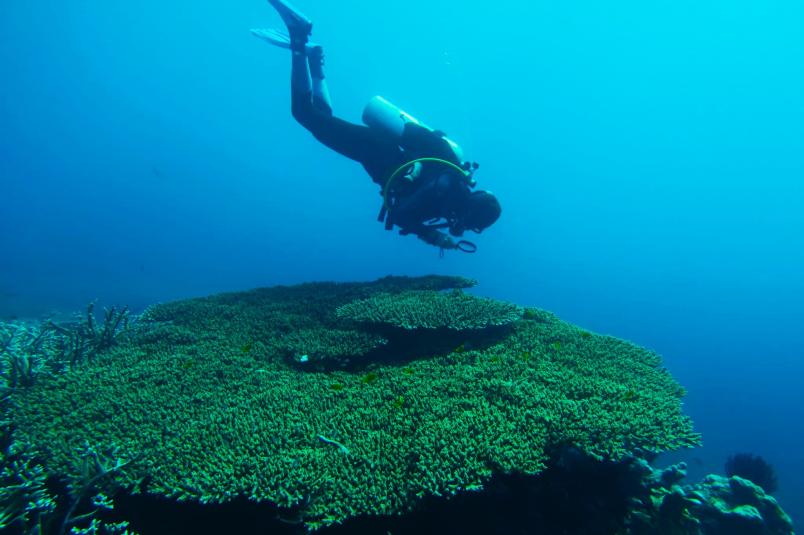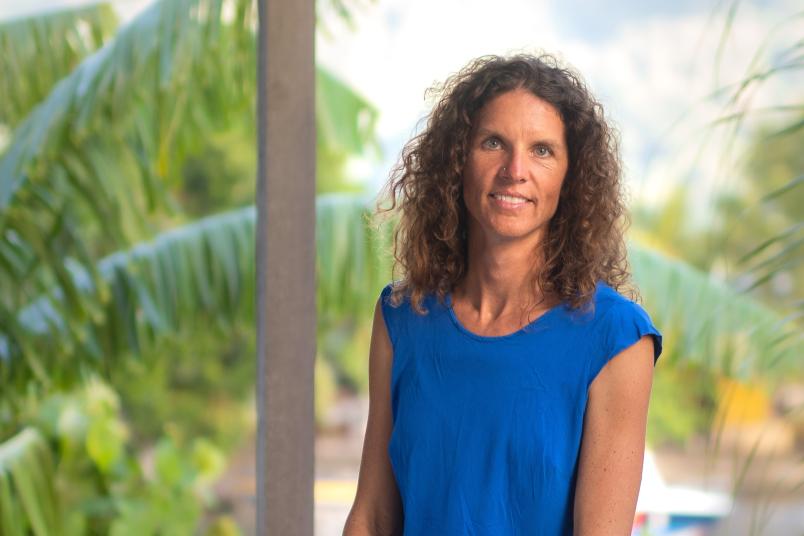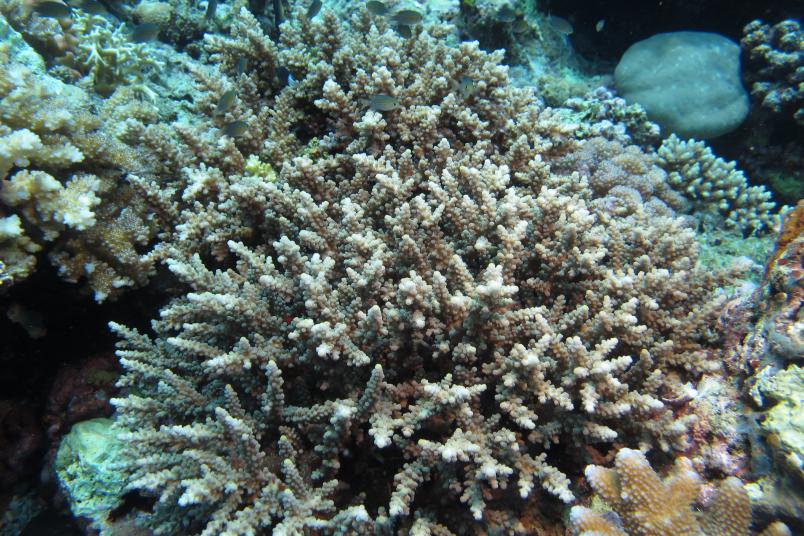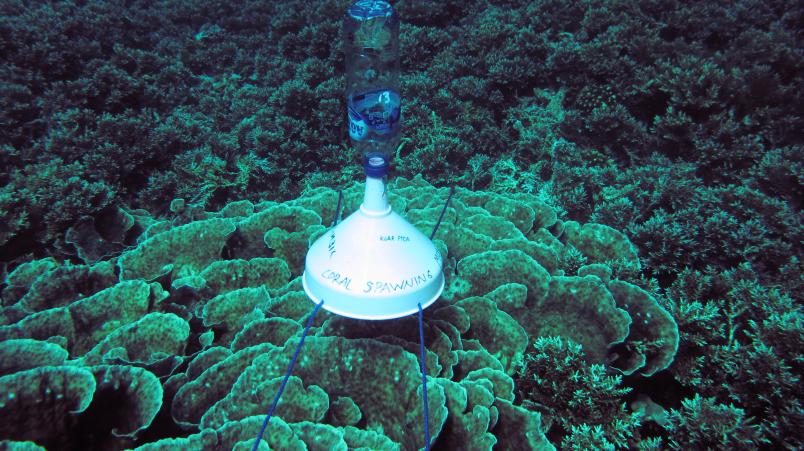Biology
Ready, steady, go
In order for the egg and sperm cells of corals from different colonies to intermingle, the individuals of one species must spawn at the same time. But how do they manage to synchronise it?
At night, when all is quiet and all you can hear on the beach of the small island of Banda Naira is the sound of the waves, Dr. Mareike Huhn from the Department of General Zoology and Neurobiology at Ruhr University Bochum sets off on her observation dives in the Indo-Pacific. The stony corals glow green and brown in the light of her torch. Brightly coloured reef fish swim around between the labyrinthine structures, where they find shelter and food. And sometimes something amazing happens: as if on command, the corals release millions of bundles of eggs and sperm into the water, rising from the reef like an orange-yellow snowstorm. We don’t know all that much about this process yet, but understanding it is important if we want to protect our planet’s coral reefs.

Corals are extremely important for life on Earth.
Mareike Huhn
Mareike Huhn has been living on the Banda Islands in Indonesia for many years to study coral reefs. The area has a particularly high species density of around 330 hard coral species. “Corals are extremely important for life on Earth,” points out the marine biologist. “70 to 80 per cent of the oxygen in our atmosphere comes from the ocean, not from forests on land. In coral reefs, photosynthesis takes place 100 times more efficiently than in the open sea.” Moreover, coral reefs are extremely rich in species. In the ocean, a quarter of all species live in or from coral reefs.
Mareike Huhn is currently trying to find out how coral populations synchronise so that all colonies of one species spawn at the same time, thus ensuring a high fertilisation rate. “If we want to preserve our planet’s coral reefs, we must be able to restore damaged reefs. This means establishing new corals in reefs that are dying, example given due to climate change factors,” says Mareike Huhn.
Coral protection
Until a few years ago, divers would go into an existing reef and collect broken-off pieces or even break off pieces of coral and replant them elsewhere. “But this damages the reef from which the corals are taken. Moreover, this approach only works for coral species that form branches,” explains Mareike Huhn. Another disadvantage is: if we plant broken-off coral pieces like a seedling, we reproduce them asexually, without mixing the genes of different populations. In the long run, this may lead to diseases and make colonies less resistant.
The approach that Mareike Huhn would like to pursue with her research is quite different: she collects the egg-sperm bundles from corals in the sea and keeps them in tanks for the first five days. This is the time when the larvae develop to the point where they are capable of colonising the seabed. She then releases the larvae into a damaged reef. In order for this method to work, she is required to know as much as possible about the spawning of the corals. Mareike Huhn got the first clues about how the corals around the Banda Islands synchronise in 2016.
Random observation
“At that time, I was already living on the Banda Islands and just happened to notice that the corals were spawning here. At the same time, I learned from the news that mass spawning had been observed in the Great Barrier Reef in Australia, about 1,000 kilometres away,” says the biologist. Her chance observations prompted her to carry out extensive monitoring. Is it possible that the corals communicate in some way when it’s time to spawn?
Mareike Huhn and her colleagues, most of whom are local researchers, came up with a way to capture and study the corals’ egg-sperm bundles. To do this, they build egg traps. These traps consist of an upside-down PET bottle with a large kitchen funnel stuck upside down into the mouth. The bottle is filled with a little air so that it is positively buoyant. The researchers attach this contraption just above a coral. When the coral spawns, the bundles float up directly into the egg trap, because the spawn is tared in such a way that it always rises to the surface.
Fertilisation in the aquarium
The egg-sperm bundles of different colonies collected in this manner are carefully stirred inside a container with sterile filtered seawater. This breaks up the bundles. The cells are examined and their DNA extracted in order to determine exactly which coral species it is. The eggs from one colony can now mix with the sperm from other colonies. Fertilisation must take place within two hours. Larvae then develop within 24 hours.
To learn more about the synchronisation of the corals, the researchers match the time of spawning with various environmental factors. This is how they hope to learn more about which signals trigger spawning. What is the tide like on the day in question? What are the mean water temperatures and the length of the day? When does the moon rise and set on that day? Is it full moon or new moon?

There must be several triggers.
Mareike Huhn
“There must be several triggers,” as Mareike Huhn sums up her observations. “Before a coral can spawn, the eggs have to mature in it for several weeks. The onset of this maturation process must also be triggered somehow – and this must happen for all corals of a species at the same time. And then the timing of the actual spawning must be triggered synchronously,” elaborates Huhn.
The researchers’ records provided answers to these riddles: according to them, environmental factor number one that triggers egg maturation is the water temperature. It always rose within one month before spawning. The relative increase in the surface temperature of the water, which must rise by 0.5 to one degree Celsius within four weeks, and the total temperature, which must be between 28 and 30 degrees, both play an equally important role.
The role of the moon
But how do the corals, some of which are spaced several hundred metres apart, synchronise the exact night of spawning? “The moon plays a major role in this process, as the animals perceive its light via light receptors on the surface of their bodies,” explains Mareike Huhn. “The corals always spawn five, six or seven days after the full moon. The exact number of days depends on the type of coral.”
The findings so far help the researchers gain a better understanding of the corals’ lives. It also allows them to schedule their dives for the nights when the animals are expected to spawn and to make further observations, as well as collect eggs to study. “Our research is by no means at an end, there are still countless unanswered questions,” concludes Mareike Huhn. She expects to spend a lot of time in her second home, Indonesia, in the coming years.





